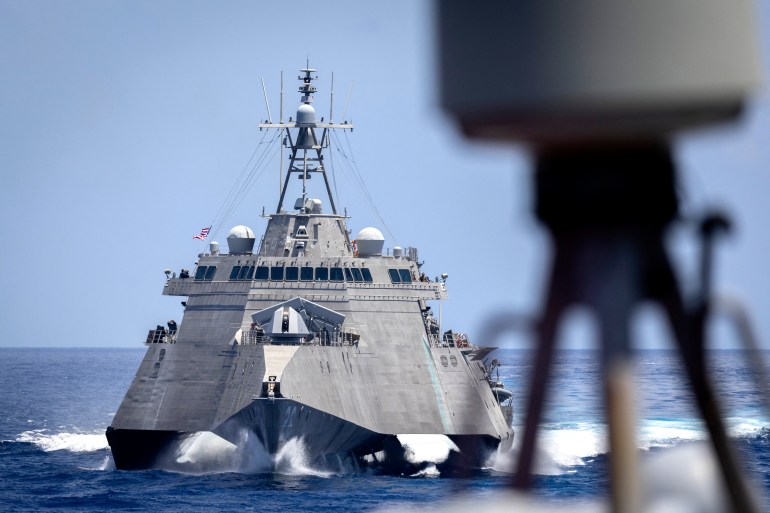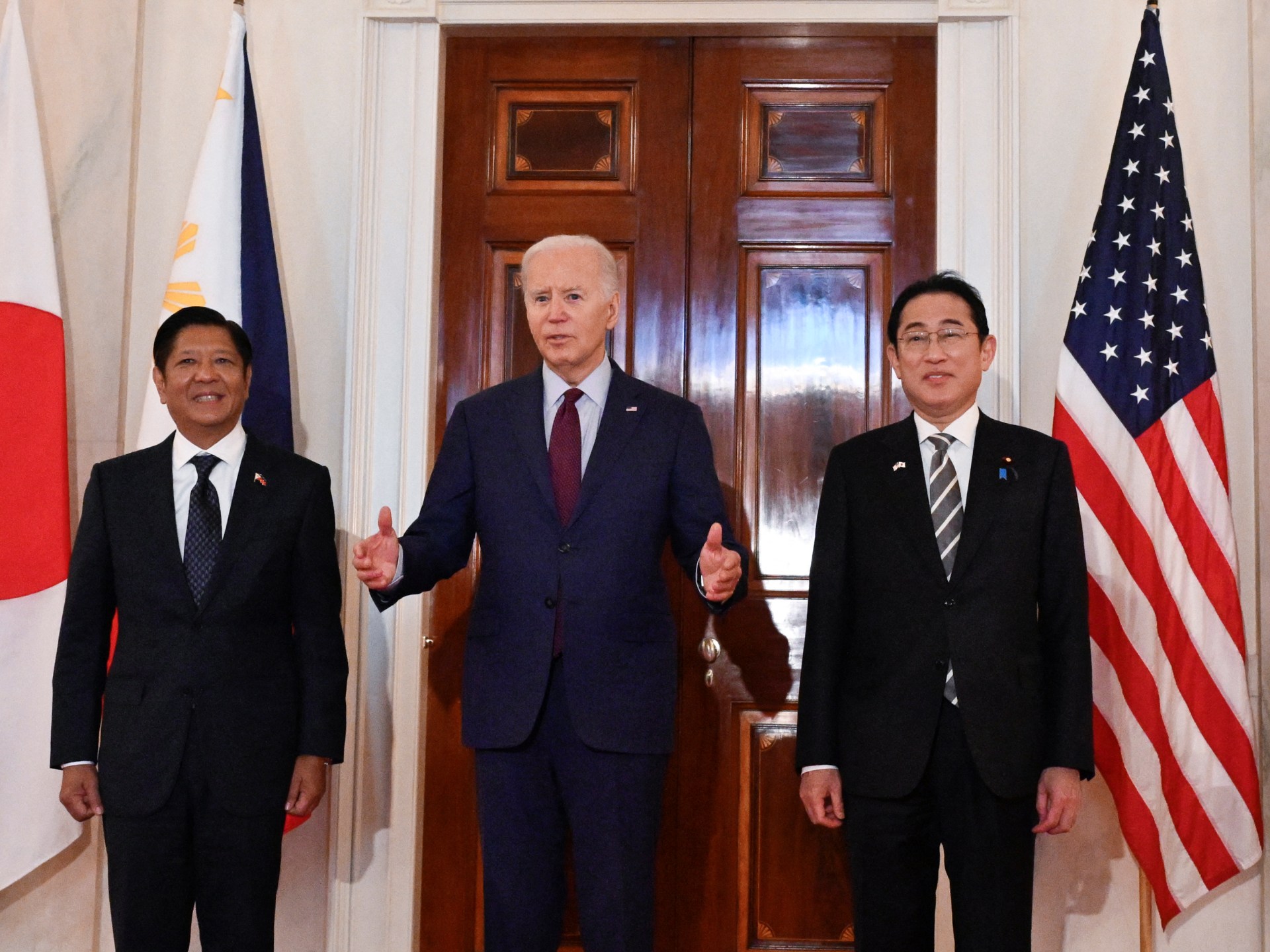Manila, Philippines – Amid rising tensions in the South China Sea between Beijing and Manila, the leaders of Japan, the Philippines and the United States have forged unprecedented cooperation to counter China.
But while U.S. President Joe Biden and Japan’s Prime Minister Fumio Kishida emphasized the security aspects of their cooperation, Philippine President Ferdinand Marcos Jr. emphasized the potential economic benefits, describing the partnership as a friendship with promised investments of around $100 billion advantages.
At the televised opening of the summit on April 11, Biden told the other two leaders: “I want to be clear. The United States’ defense commitments to Japan and the Philippines are ironclad. Any attack on Philippine aircraft, ships or forces in the South China Sea will invoke our Mutual Defense Treaty.”
Only then did Biden discuss how the US government would help the Philippines develop key economic sectors such as its semiconductor supply chain, as well as telecommunications and critical infrastructure such as ports, railways and agriculture.
In Manila, however, the presidential communications office downplayed the security aspect of the concluded summit, which had expressed “serious concerns about the dangerous and aggressive behavior of the People’s Republic of China (PRC) in the South China Sea.”
Instead, the press releases focused on US and Japanese statements about a “strong commitment to supporting the economic prosperity of the Philippines.”
Financial analysts told Al Jazeera that while Washington has linked its promised economic development to Manila’s security commitments, Manila has chosen to emphasize economic gains to obscure a sobering reality – that the country could be drawn into a military conflict with China.
“Marcos has to sell [this] to Filipinos,” financial analyst Jonathan Ravelas told Al Jazeera on Friday.
“It’s a bitter medicine, but I’m sugarcoating it so it’s easy to digest,” Ravelas said, explaining the president’s approach.
If he also focused on the security aspect, “he could anger China,” added the managing director of e-Management for business and marketing services and retired chief market strategist of the Philippines’ largest bank, BDO.
Semiconductor boost
Ravelas argues that Marcos Jr., like previous presidents, is interested in turning the country into a manufacturing and logistics center. “We are geographically located to be part of the supply chain in ASEAN,” he pointed out, as we are just a three-hour flight from the regional countries of Thailand, Singapore and Malaysia.
The summit announced the formation of the first Asia-Pacific Partnership for Global Infrastructure and Investment Corridor, dubbed the Luzon Economic Corridor. It will connect Manila with three sprawling areas on the country’s largest island, Luzon, that can host manufacturers and other large companies: the former U.S. Naval Base Subic, the former Clark Air Base and Batangas Province.
Ravelas noted that U.S. semiconductor makers were looking to diversify their locations and the Philippines’ young workforce made it a viable alternative.
According to noted political economist Sonny Africa, the United States has a military and an economic agenda. “In both cases, the Philippines appears to play an important role,” Africa, executive director of socio-economic think tank Ibon Foundation, told Al Jazeera.
“The alliance is likely to be exploited in such a way that it brings both security and economic benefits. While it is somewhat clear that the country plays a role in security-related measures against China, we believe that the alliance is also serious about examining the role of the Philippines, for example, as a location for parts of semiconductor production, but also as a source of nickel is essential for many technologies in the field of renewable energies. This is the direction of the US to achieve domestic energy security,” he said.
On the home front, “economic benefits are being played up to mitigate the Philippines’ increasing involvement in the U.S. militaristic agenda, particularly against China,” he said.
Nevertheless, he acknowledged that the economic aspects of the agreement were not just an “apparent whitewash” but were also part of Washington’s “core agenda.”
“[The] “The U.S. is really looking to build semiconductor production chains that are less focused on China and Taiwan and therefore less vulnerable and more resilient to conflict-related or other disruptions,” he said. “Similarly, the Philippines has the largest nickel reserves in the world, which is a crucial element in batteries and other renewable technologies.”
Both countries are betting heavily on the Philippines to protect their business interests amid rising regional tensions over the disputed South China Sea, a key international shipping route.
“Preserving freedom of navigation will continue to facilitate trade not only in our region but globally,” said Ron Acoba, chief investment strategist and co-founder of Trading Edge, a third-party research provider for local banks and brokerage firms.
The Philippines is in a strategic position in the South China Sea, which “acts as the throat of the Western Pacific and Indian Oceans,” according to the Institute for Maritime and Ocean Affairs, a private research think tank in Manila.
China claims sovereignty over almost the entire South China Sea, through which “more than half of the world’s annual merchant fleet tonnage and a third of all global maritime traffic pass through these chokepoints,” the institute said.
It calculates that about two-thirds of South Korea’s energy supplies, nearly 60 percent of Japan’s and Taiwan’s energy supplies, and 80 percent of China’s crude oil imports pass through the waters, some of which are also claimed by the Philippines, Brunei, Malaysia and Vietnam.
China’s claim to the sea, based on the nine-dash line rejected by an international court in 2016, extends over large parts of the Philippines’ exclusive economic zone (EEZ), including fishing grounds and potentially huge oil and gas deposits.
China has blocked all attempts by Manila to exploit the reserves. Under international law, an EEZ extends 200 nautical miles (370 km) beyond a country’s territorial sea and grants it jurisdictional rights over all natural resources.
“Politically speaking, it is right to emphasize the economic importance of the trilateral summit between the US, Japan and the Philippines,” Acoba said.
“But if you ask me, the main task is to send a ‘message’ to China that the country is interested in protecting our rights. And that, unlike the previous government, we are moving in the direction of not only protecting our rights, but actually enforcing them.”
Change dynamics
For Harry Roque, the former spokesman for Marcos Jr.’s predecessor Rodrigo Duterte, returning to the United States is a big mistake.
He blamed the turnaround on a decline in investment from China.
China’s nearly $20 billion in foreign investment rose 37 percent in Asia in 2023 – half of which went to Southeast Asia – but a report last month by Japanese media outlet Nikkei said there was no new investment at all in the Philippines Investments or construction projects from China.
The decline came even though Marcos Jr. visited Beijing in January 2023 and the presidential palace claimed he had secured $22.8 billion in “investment commitments.”
“Of course, every president for themselves,” Roque told Al Jazeera. “If the president wants a policy like that, then that’s the relationship we have with China. But broadly speaking, President Duterte’s policy has been: Let us move forward on trade and investment matters that we can and put aside matters that we have not been able to resolve in this lifetime.
“No Chinese (businessman) will invest now because I know for sure that many Chinese who want to invest have already given up because they fear that their investments may be confiscated given the hostile environment,” he said.
“Therefore, no one from China will touch the Philippines in terms of capital,” he said.

After the summit in Washington, DC, Marcos Jr. said he was confident that the deals with the US and Japan would not undermine Chinese investment.
The three leaders had previously expressed “serious concerns about the dangerous and aggressive behavior of the People’s Republic of China (PRC) in the South China Sea,” and Marcos Jr. stressed that the trilateral relationship “changes the dynamic” in Southeast Asia and the South China Sea would .
Still, he tried to reassure Beijing by saying the action was “not directed against any country.”
After a series of confrontations with the Chinese coast guard, particularly around the disputed Second Thomas Shoal, most Filipinos seem to agree that it is time for the Philippines to enforce its maritime rights with the help of the US and Japan.
The shoal where the Philippines grounded the Navy ship Sierra Madre in 1999 is about 200 km (124 miles) from the Philippine island of Palawan and more than 1,000 km (620 miles) from China’s nearest major landmass, Hainan Island.
Private polling firm Pulse Asia found that in a survey of 1,200 respondents in December 2023, 79 percent wanted Marcos to work with the U.S. to deter Chinese aggression in the South China Sea.
Only 10 percent wanted his government to work with China to ease tensions.
